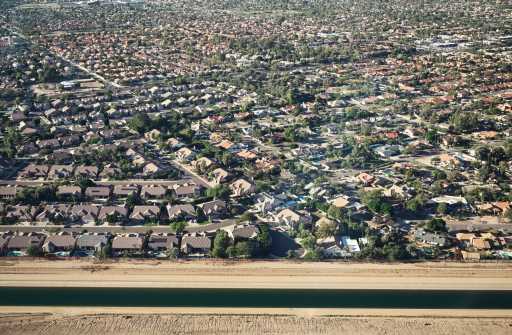
This story is one part of a broader series about ways to save water from the drying Colorado River. See the full project here.
Water experts from across the country gathered in Las Vegas in December to discuss the water shortage in the Colorado River Basin and during one panel discussion John Entsminger, general manager of the Southern Nevada Water Authority brought up growth.
The basin’s water supply is dwindling but last he checked, Entsminger said Las Vegas is still issuing building permits. So are cities like Denver, Phoenix and Los Angeles.
All of those new people and businesses are going to need water. And it’s not as though cities and states can simply turn people away at their borders.
But there are measures that state and local governments can enact to encourage current residents to save more water. And ways to grow more responsibly.
One place to start is with Kentucky Blue Grass and other types of non-native, water-dependent grasses decorating lawns across the American West. In Colorado, about half of the water used in cities goes towards watering those types of lawns. This year state legislators launched a turf replacement program, which would pay homeowners and business owners to replace their ornamental lawns with plants better suited to the region’s dry climate.
Other cities in the state already have their own turf replacement efforts, like Greeley’s Life after Lawn program. So does Castle Rock, which is also limiting the amount of water-intensive grasses that can be planted in new homes. Aurora passed a similar measure and even included golf courses in the package.
The approach works, too.
Las Vegas started a turf replacement program in 1999, offering residents money (increasing amounts as the years went by) for every square foot of lawn they were willing to replace. To date, the city has replaced hundreds of millions of square feet of turf and saved hundreds of billions of gallons of water.
Los Angeles launched a similar program in 2015, which is estimated to save up to 26 billion gallons of water each year, The Los Angeles Times reported.
This should be the approach all across the West, Jay Famiglietti, director of the Global Institute for Water Security at the University of Saskatchewan said.
“When you’re in the dry part of the world, it should look like the dry part of the world, not lush and green,” he said.
But there’s also a broader approach to managing new growth: requiring developers to show a water source before issuing a building permit.
Arizona has done this for decades. In 1980 state lawmakers passed the Groundwater Management Act, creating areas in which developers and municipal water providers must obtain permits from the state to confirm any new homes would have a 100-year water supply.
Colorado has a similar 100-year rule for new development but some communities are taking it a step (or three) further and requiring new development to show that it has a 300-year water supply. El Paso County was the first in the state to enact that measure in 1986, Adams and Elbert counties followed. Now Arapahoe County, which expects to host as many as 800,000 people by 2050 is considering it too.
These measures and others like them can help the West continue to grow sustainably, Estevan López, the Upper Colorado River Compact Commissioner for New Mexico said.
Major cities like Denver, Las Vegas, Los Angeles and Phoenix have seen success with their conservation efforts and their populations have soared while decreasing their water use either outright on a per-capita basis.
Lopez said the same is true for Albuquerque and Santa Fe, though both sit in the Rio Grande Basin, and he said governments all across the West must more aggressively adopt a mindset centered around sustainability and enact the policies to match.
“We can’t just assume the water’s gonna be there,” Lopez said.
But new legislation takes time. Arapahoe County’s 300-year-rule proposal is being considered as part of an 18-month study, which launched in December.
And a city or county ordinance often might not be enough, Jennifer Gimbel, senior water policy scholar at Colorado State University’s Water Center noted.
“Developers can just say ‘We’ll just go across the city line and build here,’” Gimbel said. “You almost need a statewide law.”
There’s also a limit to the amount of water that can be saved. Cities, counties and businesses only account for a fraction of the total water drawn throughout the basin.
For example, data from the Colorado Department of Natural Resources shows that municipal and commercial water use makes up only 6.6% of the state’s total. The biggest percentage, in every state, goes to agriculture.
Source: Read Full Article
